
Historically, natural molds available in the environment were responsible for the colonization of cured products and the positive effects of these molds on aroma, texture and preservation were confirmed. The inconsistent performance of these wild sepas has led to intentional inoculation or starter cultures to obtain a uniform quality of the final products – especially a white and uniform coverage avoiding product failures caused by harmful infestation.
The market for fermented meat products has increased over the last few decades and the explanation lies in the superior flavor and aroma compared to non-fermented ones. The use of starter cultures brings gains and control over production. It protects the surface and reduces the occurrence of hardening of the product's exterior (dry rim or case hardening). Furthermore, through proteolytic and lipolytic activity (enzymatic degradation of proteins and fats), it positively influences the maturation of the meat and provides a softer texture.
To the starter cultures currently used to inoculate mold in salami, cups and other fermented meat products are many, such as Mold-600, Mold-800, Lyocarni and Lallemand Penicilium Nalgiovense mold-600, Lyocarni and Lallemand contain the Penicillium Nalgiovense, mold-800 already contains Penicillium candidum It is Penicillium nalgiovense.
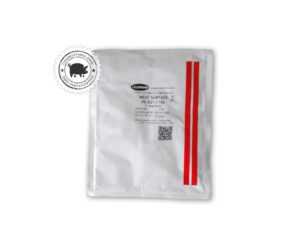
Advantages attributed to intentional fungal culture
- Reduces the appearance of “dry kidney” or “Case hardening”;
- Improves product color;
- More uniform texture throughout the product;
- Reduced drying time;
- Due to proteolytic and lipolytic action.

Cultures
Lallemand Penicilium Nalgiovense – PS-521
Penicillium nalgiovense
– Rapid growth and suppression of wild flora;
– Dense and uniform coverage;
– Traditional white covering;
– Pronounced mushroom flavor.
MOLD-600
Penicillium nalgiovense
– Rapid growth and suppression of wild flora;
– Dense and uniform coverage;
– Traditional white covering;
– Pronounced mushroom flavor.
MOLD-800
Penicillium candidum It is Penicillium nalgiovense
– Rapid growth and suppression of wild flora;
– Dense and uniform coverage;
– Light aroma of camembert / Strong flavor of mushrooms and a typical aroma of moss;
– Greater growth potential in unstable environments (temperature and humidity).
How to use
Dosage
As a general rule: 25g of culture for 10 liters of water
Most important growth factors
Growth should appear within 2 days (white round dots). Molds grow unevenly, so it is very important to get an even distribution of spores. If growing conditions are adverse (cold, strong ventilation, dry), the spores may grow very slowly and there will be large bare patches and wild molds may emerge.
Product type: The proportion of fat and lean meat determines the transfer of moisture to the casing and therefore the conditions for mold growth. Areas with more or less fat modify evaporation, making regions more and less favorable to mold.
Cellulose Casing: It is not ideal as it has a dry surface. It must be moistened beforehand. Growth takes longer than in natural casings. Some molds react with cellulose and can create holes.
Collagen Casing: Lower growth potential than natural casing but higher than cellulose casing.
Natural casings: They must be thoroughly cleaned before use. It is great for obtaining perfect, dense coverage of the product. In some cases, more stringent growth control may be necessary to prevent excessive mold growth.
Fermentation: Mold success depends on good moisture regulation, which can be used to encourage or inhibit mold growth. Furthermore, it requires air speed adjustment and temperature control.
General rule
- Ideal humidity for growth > 90%;
- Air circulation should be moderate to low;
- The temperature should be between 24–30°C.
Moisture: If the difference between the humidity of the air and the product is too great, evaporation may be excessive, resulting in a dry product on the outside. Dry exterior inhibits spore development.
Temperature: Temperatures above 24°C produce good spore development. Lower temperatures reduce the growth rate and very low temperatures impede development. The temperature must not exceed 30°C.
Air circulation: It should be low at the beginning (0.1 to 0.2 m/s) and should not exceed 0.6 m/s. High speeds are used to create a crust on products and very low speeds reduce moisture loss. Fresh (external) air ventilation must preferably pass through filters to avoid contamination.
Application
Soaking the product: The water must be constantly stirred to avoid spores depositing at the bottom of the container. The product must be completely submerged.
Spray: The product must be kept moving and turned constantly.
Common Problems
Greenish coverage
– Wild mold suppressed the starter culture;
– Additional uncontrolled proliferations occurred.
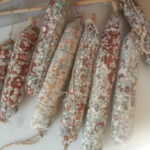
Mucus
– Environmental contamination;
– Contamination from handling or casing.
Emergence of wild cultures
– Existence of colonies in the environment;
– Circulation of contaminated air, without filters.
Mold did not cover the product
– Another colony killed the inoculated starter culture;
– Layer of bacteria prevents mold from attaching itself to the casing.
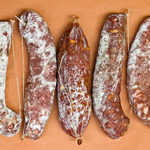
Very intense mold coverage
– Very high humidity;
– Natural casings were not cleaned correctly;
– High humidity for a very long period.
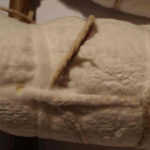
Very weak mold coverage
– Little humidity during the initial fermentation period;
– Very high ventilation;
– Very low temperature.
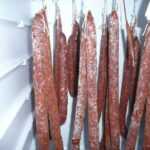
Wild mold covered the inoculated
– Remove all natural mold before applying the starter culture;
– Contamination of external ventilation;
– Incorrect conditions for the growth of the starter culture;
– Incorrect fermentation and drying.
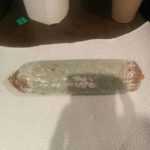
Very strong “ammonia” aroma
– Excess Penicillium Candidum;
– Fermentation and drying cycle killed the starter culture. Dying mold produces more ammonia;
– Use more penicillium nalgiovense.
Sticky surface
– Bacterial contamination;
– Incorrect fermentation, late drying;
– Problems with casings;
– Poor or lack of ventilation.
Source: CHR-Hansen
Video about the use of penicilium nalgiovense




Good morning, can I use it for any cure? cup, ham, loin, etc? Another question, if the product is already contaminated, how and with what do I need to wash it before adding the new culture?
thanks
Yes, you can use it in any cured/matured product. If the product already has mold, the ideal is to change the casing or clean it well by brushing or rubbing the item under running water and then apply the culture.
Good morning. I bought a pack of MOLD 600 and I didn't put it in the freezer but I also haven't opened it yet. It's about 7 days old. Still good? Or have I lost culture?
Hi Luan, the mold culture lasts around 15 days out of the freezer, you can use it, it will most likely be fine.
I produced the salami with the addition of wine (for acidity) and curing salt within specifications. I chose to use pinicillium candida (Brie), as it was easier to find. I applied it with a spray bottle for just two days and the copa and salami have already acquired a velvety appearance and are well distributed on the surface of the products. I recently cleaned some native fungi that were proliferating and are very presentable, but I have two doubts about the appearance and smell.
As I had never used penicillium, I was amazed at the speed and quantity of fungus produced in such a short period of time. The fungus looks good (velvety white layer), but due to the large quantity I don't know if it is correct. Another issue is the ammonia smell. This is normal, should I do something when this smell comes out?
Hi Homer. Penicillium candidum has the characteristic of forming a very thick layer when conditions are favorable, as we see in brie cheese, it looks very beautiful. The smell is also something that can occur due to the strong presence of the fungus. A slightly bitter taste too. If you want, save a little of the coating to reduce the amount, it should help reduce the smell and possible flavor left in the salami.
Good afternoon! When the salami has reached the target weight loss, can I vacuum pack it with the MOLD cover? The pieces are all white and I really like that look, but I heard that in a vacuum they would die. It turns out that I already bought a vacuum-sealed French saucisson covered in fungus once and it was great…
Hi Marcos, the fungi will die but the coverage that has already been created will remain. There will only be no subsequent proliferation due to the anaerobic environment. I have never read any study that mentions this impediment to vacuum sealing with the fungus.
Good afternoon, can I proceed in the same way to store the bactoferm in the freezer as well as the mold after opening.
Good afternoon, I would like to know if I can store the starter culture in the refrigerator, I bought an envelope and used just a pinch to dissolve it in 100ml for spraying. Another question, how long can I keep this liquid? Can it be in the fridge? I thank!
Hi Ernesto, store the powder in the original envelope, tightly closed, in the freezer. Unfortunately, there is no way to use the liquid with the hint of culture already dissolved, it is best to discard it after a maximum of two hours. One use for this excess is to spray or rub it on the walls of the place where you will leave the products hanging. The environment also helps transfer fungi to products.
Thank you very much! Wu opened the packaging, the culture, last Saturday and had stored it in the refrigerator. I transferred it to the freezer today, did I lose it? I thank!
Hi Ernesto. No problem, mold (fungal) cultures have excellent durability and can last for a long time outside the ideal temperature. Fungi are very, very resistant. In the next applications you will see that the fungus will most likely prosper in the same way. Hugs!
Eduardo, thank you very much for your support! Big hug!
Where can I find this product to buy?
https://charcutaria.org/produto/cultura-mold-penicillium/
Can I use mold 600 raw ham
Yes, it can, it will even help control moisture loss.